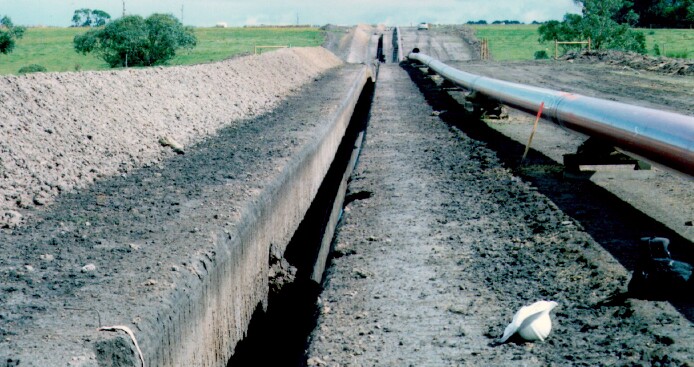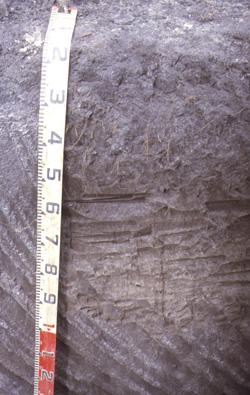SW62
Location: Simpson.
Australian Soil Classification: Humose-Acidic, Tenosolic, Redoxic HYDROSOL (thick, non-gravelly, sandy, deep).
General Landscape Description: Gently undulating plain.
Site Description: Broad (50-100 m) flat to slightly concave element between two shallow drainage lines.
Geology: Hanson Plain Sand.
Land Use: Dairy cattle grazing.
 SW62 Landscape |
Soil Profile Morphology:
Surface Soil
A1 Bg | 0-40 cm 40 cm+ | Black (10YR2/1); loamy fine sand; massive; firm consistence dry; pH 4.3; gradual and wavy change to: Very dark greyish brown (10YR3/2) becoming mottled with depth (90 cm+); loamy fine sand; massive; firm consistence dry; pH 4.7. | |||
 SW62 Profile. | |||||
Soil Profile Characteristics:
pH | Salinity Rating | |||
Surface (A1 horizon) | Extremely Acid | Low | Non-Sodic | None |
Subsurface (A2 horizon) | Very Strongly Acid | Low | Non-Sodic | - |

| The surface is extremely acid. The subsoil is very strongly acid. | Salinity rating is low throughout the profile. | Exchangeable Aluminium levels are very high throughout the profile. | Coarse sand levels are high throughout the profile. | Clay levels are low throughout the profile. |
Horizon | Horizon Depth (cm) | pH (water) | pH (CaCl2) | EC (dS/m) | Exchangeable Cations | |||
Ca | Mg | K | Na | |||||
meq/100g | ||||||||
A1 | 0-40 | 4.3 | 3.4 | 0.13 | 0.35 | 0.53 | 0.09 | 0.62 |
A2g | 40+ | 4.7 | 4 | <0.05 | <0.05 | 0.09 | <0.05 | 0.1 |
Horizon | Horizon Depth (cm) | Oxidisable Organic Carbon % | Total Nitrogen % | Exchangeable Aluminium mg/kg | Exchangeable Acidity meq/100g | Coarse Sand (0.2-2.0 mm) | Fine Sand (0.02-0.2 mm) | Silt (0.002-0.02 mm) | Clay (<0.002 mm) |
A1 | 0-40 | 4.4 | 0.13 | 230 | 18 | 19 | 49 | 23 | 5 |
A2g | 40+ | 110 | 6 | 28 | 47 | 19 | 6 |
Management Considerations:
Whole Profile
- The soil profile is likely to be saturated for a number of months during most years.
- Exchangeable aluminium levels are high in the extremely acid surface soil. This will restrict the growth of aluminium sensitive species. High levels of aluminium will also tend to “fix” phosphorus and make it less available to plants (and therefore reduce the effectiveness of applied P fertilisers). Raising the pH level of the soil by liming will help reduce the level of exchangeable aluminium. A lime test (sampled across the whole paddock) may be appropriate to determine the amount of lime needed to raise pH. However, other factors need to be considered before lime is recommended e.g. species growth, method of application, trial response, likely cost benefit.
- Manganese toxicity can occur in strongly acid soils, especially when waterlogging occurs. Raising the pH by lime application will assist in reducing any manganese toxicity.


